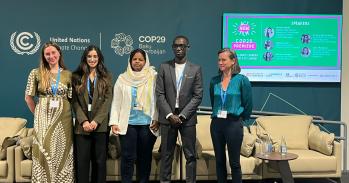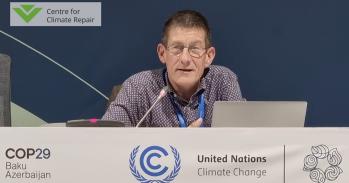
As clothes become cheaper and fashion becomes 'faster', how are we to balance our consumption with environmental, economic and social sustainability?
As clothes become cheaper and fashion becomes 'faster', how are we to balance our consumption with environmental, economic and social sustainability?
Any change that will result in environmental and social benefits in the textile industry will be driven by consumers
Dr Julian Allwood
As clothes become cheaper and fashion becomes 'faster', how are we to balance our consumption with environmental, economic and social sustainability?
Growing out of the ‘green’ movement of the 1960s, concerns over the environment began to turn towards ‘sustainability’ in the 1990s. Today, interest is also sharply focused on the issue of greenhouse gas emissions, and consumers in developed economies have become increasingly aware of the environmental impact of the products they buy and the social conditions of those who make them.
There are signs that this awareness is beginning to influence the way people shop. Last year, Marks and Spencer (M&S) decided, at some risk, to convert all of its coffee and tea sales to products made under the ‘Fairtrade’ agreement (which helps disadvantaged producers in the developing world). Sales grew 12% immediately and, after a year, remain 6% higher than previously.
These environmental and social concerns are no less true for the clothing industry. Dr Julian Allwood and researchers at the Institute for Manufacturing in the Department of Engineering have been exploring the environmental, social and economic sustainability of a wide range of future scenarios for the supply of clothing and textiles to the UK. The project involved five person-years of effort and led to a major report entitled Well Dressed? published in December 2006.
The price of fast fashion
The environmental consequences of our textile consumption are complex and occur at different stages of a garment’s life: from the cultivation of cotton, through garment manufacture, laundering and disposal at the end of its life.
Specific effects on the environment include the use of toxic chemicals in cotton agriculture and manufacture; the high water consumption, particularly for cotton crop cultivation; the contribution to climate change through energy use during manufacture and by laundering clothes; and the solid waste created from the manufacture and disposal of clothing.
These environmental concerns go hand-in-hand with social concerns about the employment of low-paid workers in developing countries, particularly their working hours and safety, and the use of child labour. There are recognised needs for a realistic minimum living wage that would allow workers to escape a cycle of poverty and the rights of workers to form unions.
The solution? Buy less, keep it longer
The main conclusion of the analysis is that the impacts of the sector are largely driven by the volume of material passing through it – so the greatest beneficial change would occur if we purchased less clothing and kept it for longer. Although this appears economically negative, it need not be – it could be achieved if we spent twice as much on half the number of (higher quality) garments.
Separately from reducing the flow of material, improvements can be achieved by increasing the efficiency of each process applied to the material. The most important process at present is that of laundering – washing clothes at lower temperatures and hang-drying to avoid use of a tumble dryer would approximately halve the total life-cycle energy used by cotton garments. Also, moving from conventional to organic cotton would eliminate the use of toxic chemicals. And increasing the re-use of materials (particularly of man-made materials such as polyester) would save the high energy requirement of new material production.
Weaving the threads of change
An understanding that emerged from this study is that any change that will result in environmental and social benefits in the textile industry will be driven by consumers. How would an ‘ideal’ consumer act? They would buy fewer, longer-lasting garments, choosing those with the least ‘carbon footprint’ made by workers in reasonable working conditions; buy more second-hand clothing; wash clothes less often at a lower temperature using eco-detergents; and recycle those clothes that had reached the end of their lives.
If consumers change their behaviour, companies will follow very quickly, and politicians may follow also. The experience of M&S with Fairtrade tea and coffee shows how companies can begin to take a lead in supporting such change – but however willing the company, they can only move with their customers. Consumer education is the key to supporting a move towards beneficial change. The very positive media reaction to Well Dressed? has shown that there is growing public interest in responding to concerns about ‘sustainability’ and it is hoped that some of the outcomes will also translate to other sectors.
A world trade
The clothing and textile industry is a significant part of the world’s economy: In 2000, approximately $1trillion was spent on clothes by consumers worldwide, a third of this in western Europe and a third in North America.
- The industry directly employs at least 26 million people and accounts for around 7% of total world exports.
- More than a quarter of the world’s production of clothing and textiles is in China, with Pakistan, Bangladesh and India also making a significant contribution. Trade in clothing and textiles accounts for more than 70% of the exports of Cambodia, Bangladesh and Pakistan.
- The European Union and Mediterranean region retain a strong clothing and textiles industry – with over 4 million people employed, including around 200,000 in the UK.
- In the UK, we spent an estimated £625 per head on clothing in 2004. Increased spending between 2001 and 2005 coincided with dropping prices largely due to the rise of ‘fast fashion’ – with sales at supermarkets and chains such as H&M and Zara providing a faster turnover of styles than previously.
- Today, we are purchasing and disposing of around 35 kg of clothing and textiles per person each year, of which around 13% is collected for re-use, 13% is incinerated, and the remainder – 26 kg per person – is buried in landfill.
For more information, please contact the author Dr Julian Allwood (jma42@cam.ac.uk) at the Department of Engineering. This research was funded by the UK’s landfill tax credit scheme through Biffa and a contribution from M&S. The full report Well Dressed? The Present and Future Sustainability of Clothing and Textiles in the UK can be downloaded from https://www.ifm.eng.cam.ac.uk/resources/sustainability/well-dressed/.
This work is licensed under a Creative Commons Licence. If you use this content on your site please link back to this page.





